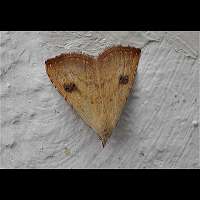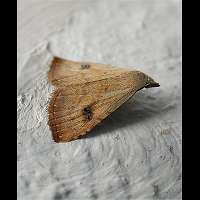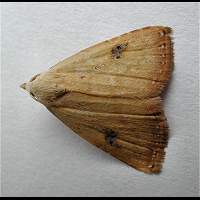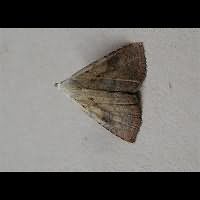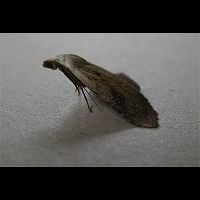Straw Dot Rivula sericealis
This very small Owlet Moth is unmistakable and often flies by day. Most striking about it are the two huge kidney markings, which appear to be black. Close inspection however reveals they are actually deep purple with a black center. When resting it assumes a posture not unlike the concorde's. The head is held very high and always points downwards. Darker animals such as the one depicted in the pictures in the middle are very rare. The only similar species is a Pyralid Moth: the Garden Pebble (Evergestis forficalis). It has the tips of the wings more pointed, a black line or smear in the point of the wings and it is considerably bigger, reaching a wingspan of 27 to 32mm. The Straw Dot reaches a wingspan of no more than 25mm.
In Southern England the Straw Dot flies in two generations. The larvae of the second generation appear from August onwards. They feed, but do not grow very quickly. They go into hibernation when still very small. The larvae feed by night and hide among the stems of the food plants during the day. When it is time to pupate, the caterpillars spin a cocoon, which they attach to the stems of the foodplant. It is placed closed to the ground. Pupation takes place inside the cocoon and lasts, varying with the temperature three to four weeks. The caterpillars are easily identified. They are of a harsh, rather dark green colour. A thin dark green dorsal line is accompanied on both sides by a rather broad, white and slightly curled subdorsal line. There is a striking yellow patch on the back of the 8th segment. The animal is hairy. The hairs are very thin, quite long and not very numerous. The larvae reach a length of some 15 to 20mm. They feed on various grasses, including the well known Purple Moor-grass.
The Straw Dot flies in two generations in the south of England. There it is seen from the end of May to the end of September. In other parts of Britain there is one generation each year, on the wing in June and July. It flies during the day in small numbers and is also seen visiting flowers in broad daylight. Is very easily disturbed from its resting place. Comes to light in small numbers, but is not responsive towards sugar. Rather difficult to take pictures of, for it is restless and easily disturbed. However when found resting during the day on a solid background, such as a wall, tree trunk or fence, it usually doesn't give you any trouble, as long as you don't touch it. Widespread and very common all over Britain, except for the eastern parts of Northern England and Scotland where it is uncommon. Elsewhere in Northern Britain it is common, including the Hebrides. Very common on the continent as well. Has three generations in Holland and Belgium and possibly four in the Mediterranean. There are some indications this might be a migrating species.
This very small Owlet Moth is unmistakable and often flies by day. Most striking about it are the two huge kidney markings, which appear to be black. Close inspection however reveals they are actually deep purple with a black center. When resting it assumes a posture not unlike the concorde's. The head is held very high and always points downwards. Darker animals such as the one depicted in the pictures in the middle are very rare. The only similar species is a Pyralid Moth: the Garden Pebble (Evergestis forficalis). It has the tips of the wings more pointed, a black line or smear in the point of the wings and it is considerably bigger, reaching a wingspan of 27 to 32mm. The Straw Dot reaches a wingspan of no more than 25mm.
In Southern England the Straw Dot flies in two generations. The larvae of the second generation appear from August onwards. They feed, but do not grow very quickly. They go into hibernation when still very small. The larvae feed by night and hide among the stems of the food plants during the day. When it is time to pupate, the caterpillars spin a cocoon, which they attach to the stems of the foodplant. It is placed closed to the ground. Pupation takes place inside the cocoon and lasts, varying with the temperature three to four weeks. The caterpillars are easily identified. They are of a harsh, rather dark green colour. A thin dark green dorsal line is accompanied on both sides by a rather broad, white and slightly curled subdorsal line. There is a striking yellow patch on the back of the 8th segment. The animal is hairy. The hairs are very thin, quite long and not very numerous. The larvae reach a length of some 15 to 20mm. They feed on various grasses, including the well known Purple Moor-grass.
The Straw Dot flies in two generations in the south of England. There it is seen from the end of May to the end of September. In other parts of Britain there is one generation each year, on the wing in June and July. It flies during the day in small numbers and is also seen visiting flowers in broad daylight. Is very easily disturbed from its resting place. Comes to light in small numbers, but is not responsive towards sugar. Rather difficult to take pictures of, for it is restless and easily disturbed. However when found resting during the day on a solid background, such as a wall, tree trunk or fence, it usually doesn't give you any trouble, as long as you don't touch it. Widespread and very common all over Britain, except for the eastern parts of Northern England and Scotland where it is uncommon. Elsewhere in Northern Britain it is common, including the Hebrides. Very common on the continent as well. Has three generations in Holland and Belgium and possibly four in the Mediterranean. There are some indications this might be a migrating species.

